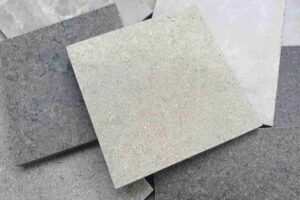The Real Terrazzo Tiles vs. the Terrazzo Look-Alike (A Comparative Analysis)
There is no gainsaying that terrazzo tiles represent one of the hottest choices for finishing home floors and walls. At the moment, it is common to see people using terrazzo tiles everywhere in the home, such as kitchen benchtops, living room furniture, walls, and of course, floors.
The vital options in terrazzo tiles make it more enjoyable when you apply the best, durable, and most effective finishing materials to your home. But due to the cost of installing terrazzo tiles, designers have created a faux look-alike for the genuine terrazzo tiles.
Overview of differences between the genuine terrazzo tiles and the faux terrazzo tiles
Generally, you may not get a difference when comparing the natural terrazzo tiles with the faux by physical look. This case is not strange as that is the primary reason the latter was created. While the natural terrazzo is high-quality, the mock has a significant build-up.
The natural terrazzo is chipped like glass or marble particles held together in a composite material. This material usually has a thicker nature of about 20 mm that is strong enough to prevent cracking due to the load.
On the other hand, the faux terrazzo has a unique pattern for the porcelain tile. Whereas the same method has been applied to the cement encaustic tiles. Meanwhile, technology has simply come a long way to create a replica of the realistic system of terrazzo tiles.
Pros and Cons of Terrazzo Tiles and its Look-alike
There are many ways and effects that the original terrazzo tiles can be compared with the faux. One of the most significant differences is the price of each type. For instance, the terrazzo tiles cost between 120 and 250 USD per square meter.
On the other hand, the terrazzo tiles look-alike costs far less, between $35m2 and $85m2. Meanwhile, the installation cost for the genuine tiles may also be an essential factor to consider. For instance, real terrazzo tiles can be more expensive than faux terrazzo tiles.
Similarly, when you consider the thickness of the terrazzo tiles, you need to choose the best one that works for your project. You need to prepare ahead from the start of the project. In the case of home renovations, you may need a thorough examination to decide which one works better.
When installing the terrazzo tiles, you may also need to see how it works with the space at your disposal. For instance, do they merge smoothly with the available space or require bending at an angle. Suppose you need to lay them at an angle. In that case, you may need to apply another product to maintain the floor’s shape and prevent any hazard or accident.
A professional installer must also consider the differences between the genuine terrazzo tiles and the look-alike maintenance. For instance, the natural terrazzo tiles are often porous. Even when sealed, they can become less suitable for some areas, such as under the bathroom shower. learn more about floor terrazzo tiles at http://nttcominsight.com/the-uniqueness-of-poured-terrazzo-flooring-tiles/
As a result, before installing terrazzo tiles in your home in Sydney, Australia, ensure you seal them smoothly with suitable materials. At the same time, this seal protects the surface from any grout stain as it is now easier to clean. Once your grout and clean up the tiles after installation, the next thing is to seal.
The sealing requires penetrating attributes, which prevents staining from occurring on it. Also, it enhances the cleaning of these tiles and other maintenance strategies. At the same time, cleaning terrazzo tiles requires using a neutral substance in its pH as it can give it the best look without interference.
Terrazzo tiles are also susceptible to different materials. Therefore, many installers may dodge this opportunity when installing terrazzo in bathrooms and toilets because it involves laying them under showers.
However, in this case, you can install the terrazzo look-alikes there instead of the. More so, no one has to know the trick that ensures that the vanity works for other places, such as your vanity top.
Color and Patterns of Terrazzo Tiles
There are many colors and patterns for the genuine terrazzo tiles and the look-alike tiles. For instance, if you lay your hands on the contemporary white color, you may be on the way to creating a simple heavenly design.
On the other hand, brown color tones can also be calm and soft for use while there are different related colors. At the same time, there are some big chips or more minor flecks that may add unique textures to the terrazzo tiles. Diversifying these collections adds some level of drama.
Sizes of Terrazzo Tiles
As expected, the sizes of terrazzo tiles differ in a significant way. For instance, the standard length is about 400 x 400 x 16 mm. The alternative size is the 600 x 600 x 20 mm format. Meanwhile, both the interior designer and the supplier can maximize their budget and space.
However, professional tilers can often deal with any format you prevent them and shapes. More importantly, they can easily factor in the floor or wall space process compared to the tile sizes. You can check out more diverse options in the terrazzo tiles.
Conclusion – Are terrazzo floor tiles still in vogue?
When it has all been said and done, one question someone may ask is if terrazzo tiles altogether are still in vogue. That is, instead of choosing between the real and the faux terrazzo tiles, why not choose another material for the flooring entirely?
One clear evidence is that the style that terrazzo floors create is hard to replicate. If you can beat the attractive design and pattern, you may not exceed the durability. And if you find a material with high durability, it may not be easy to maintain, and so on.
Therefore, terrazzo floors still prove themselves a far more stylish choice of material than concrete floors in both residential and industrial environments. Any base made of terrazzo still stands out till tomorrow and returns a considerable value for the investment of installation and maintenance.

